System Dynamics-Based Integrated Benefit Analysis of Low-Carbon Management Process of Municipal Solid Waste
Abstract
1. Introduction
2. Methodology and Data Sources
2.1. The Framework of the LMDI Approach
2.1.1. Methodology of LMDI
2.1.2. Driving Forces Analysis
2.2. The Framework of the SD Approach
2.2.1. Methodology of SD
2.2.2. Model Framework and Construction
MSW Generation and GHG Emission Accounting Subsystem
Socio-Economic Benefits Assessment Subsystem
Environmental Impact Assessment Subsystem
2.3. Scenario Setting
2.4. Data Sources
3. Results
3.1. Identification and Quantification of MSW GHG Emission Drivers
3.2. Results of the Assessment of Socio-Economic Benefits
3.3. Results of the Assessment of Environmental Impacts
4. Discussions and Policy Recommendations
4.1. Discussion
4.2. Policy Recommendations
- (1)
- Enhance the pathway of CH4 utilization, and improve the utilization rate of CH4
- (2)
- Optimize the structure of MSW treatment and establish a comprehensive MSW separation system
- (3)
- Encourage public green behavior and promote low-carbon consumption patterns
5. Conclusions
Author Contributions
Funding
Institutional Review Board Statement
Informed Consent Statement
Data Availability Statement
Conflicts of Interest
References
- Rao, C.; Huang, Q.; Chen, L.; Goh, M.; Hu, Z. Forecasting the carbon emissions in Hubei province under the background of carbon neutrality: A novel Stirpat extended model with Ridge regression and scenario analysis. Environ. Sci. Pollut. Res. 2023, 30, 57460–57480. [Google Scholar] [CrossRef] [PubMed]
- Zhang, C.; Dong, H.; Geng, Y.; Song, X.; Zhang, T.; Zhuang, M. Carbon neutrality prediction of municipal solid waste treatment sector under the shared socioeconomic pathways. Resour. Conserv. Recycl. 2022, 186, 106528. [Google Scholar] [CrossRef]
- Ritchie, H.; Rosado, P.; Roser, M. Emissions by Sector: Where do Greenhouse Gases Come From. 2022. Available online: https://ourworldindata.org/emissions-by-sector (accessed on 1 January 2024).
- Kittipongvises, S.; Polprasert, C. GHGs emissions and Sustainable Solid Waste Management. In Recycling of Solid Waste for Biofuels and Bio-Chemicals; Springer: Singapore, 2016; pp. 55–85. [Google Scholar] [CrossRef]
- National Bureau of Statistics of China. China Statistical Yearbook 2022; China Statistics Press: Beijing, China, 2022.
- Wang, W.; You, X. Benefits analysis of classification of municipal solid waste based on system dynamics. J. Clean. Prod. 2021, 279, 123686. [Google Scholar] [CrossRef]
- Nanda, S.; Berruti, F. Municipal solid waste management and landfilling Technologies: A Review. Environ. Chem. Lett. 2020, 19, 1433–1456. [Google Scholar] [CrossRef]
- Jeswani, H.; Azapagic, A. Assessing the environmental sustainability of energy recovery from municipal solid waste in the UK. Waste Manag. 2016, 50, 346–363. [Google Scholar] [CrossRef]
- Assamoi, B.; Lawryshyn, Y. The environmental comparison of landfilling vs. incineration of MSW accounting for waste diversion. Waste Manag. 2012, 32, 1019–1030. [Google Scholar] [CrossRef] [PubMed]
- Kourkoumpas, D.; Karellas, S.; Kouloumoundras, S. Comparison of Waste-to-Energy Processes by Means of life cycle analysis principles regarding the global warming potential impact: Applied case studies in Greece, France and Germany. Waste Biomass Valorization 2015, 6, 605–621. [Google Scholar] [CrossRef]
- Yu, Y.Q.; Zhang, w. Greenhouse gas emissions from solid waste in Beijing: The rising trend and the mitigation effects by management improvements. Waste Manag. Res. 2016, 34, 368–377. [Google Scholar] [CrossRef]
- Usiung, L.; Jeongwoo, H.; Michael, W. Evaluation of landfill gas emissions from municipal solid waste landfills for the life-cycle analysis of waste-to-energy pathways. J. Clean. Prod. 2017, 166, 335–342. [Google Scholar] [CrossRef]
- Liu, Y.; Sun, W.; Liu, J. Greenhouse gas emissions from different municipal solid waste management scenarios in China: Based on carbon and Energy Flow Analysis. Waste Manag. 2017, 68, 653–661. [Google Scholar] [CrossRef]
- Luiza, S.B.L.; Deborah, S.B.L.; Bezerra, B.S. Environmental analysis of organic waste treatment focusing on composting scenarios. J. Clean. Prod. 2016, 155, 229–237. [Google Scholar] [CrossRef]
- Xiao, S.; Dong, H.; Geng, Y.; Tian, X. Low carbon potential of urban symbiosis under different municipal solid waste sorting modes based on a system dynamic method. Resour. Conserv. Recycl. 2022, 179, 106108. [Google Scholar] [CrossRef]
- Zaman, A.U. A comprehensive study of the environmental and economic benefits of resource recovery from Global Waste Management Systems. J. Clean. Prod. 2016, 124, 41–50. [Google Scholar] [CrossRef]
- Rahman, M.M.; Rahman, S.M.; Rahman, M.S. Greenhouse Gas Emissions from Solid Waste Management in Saudi Arabia-Analysis of Growth Dynamics and Mitigation Opportunities. Appl. Sci. 2021, 11, 1737. [Google Scholar] [CrossRef]
- Zhao, W.; van der Voet, E.; Zhang, Y. Life cycle assessment of municipal solid waste management with regard to greenhouse gas emissions: Case study of Tianjin, China. Sci. Total Environ. 2009, 407, 1517–1526. [Google Scholar] [CrossRef]
- De Feo, G.; Ferrara, C.; Finelli, A. Environmental and economic benefits of the recovery of materials in a municipal solid waste management system. Environ. Technol. 2017, 40, 903–911. [Google Scholar] [CrossRef] [PubMed]
- Nie, Y.; Wu, Y.; Zhao, J. Is the finer the better for municipal solid waste (MSW) classification in view of recyclable constituents? A comprehensive social, economic and environmental analysis. Waste Manag. 2018, 79, 472–480. [Google Scholar] [CrossRef] [PubMed]
- Ang, B.W.; Zhang, F.Q. A survey of index decomposition analysis in energy and environment studies. Energy 2000, 25, 1149–1176. [Google Scholar] [CrossRef]
- Wang, W.W.; Zhang, M.; Zhou, M. Using LMDI method to analyze transport sector CO2 emissions in China. Fuel Energy Abstr. 2011, 36, 5909–5915. [Google Scholar] [CrossRef]
- Guo, B.; Geng, Y.; Franke, B. Uncovering China transport CO2 emission patterns at the regional level. Energy Policy 2014, 74, 134–146. [Google Scholar] [CrossRef]
- Sun, W.Q.; Cai, J.J.; Yu, H. Decomposition analysis of energy-related carbon dioxide emissions in the iron and steel industry in China. Front. Environ. Sci. Eng. 2012, 6, 265–270. [Google Scholar] [CrossRef]
- Xu, J.H.; Fleiter, T.; Eichhammer, W. Energy consumption and CO2 emissions in China cement industry: A perspective from LMDI decomposition analysis. Energy Policy 2012, 50, 821–832. [Google Scholar] [CrossRef]
- Wang, M.; Feng, X.Z.; An, Q. Research on Green and Low Carbon Development Strategy of Qinghai Province Based on Decoupling Index and LMDI. Clim. Change Res. 2021, 17, 598–607. (In Chinese) [Google Scholar]
- Chontanawat, J.; Wlboonchutlkula, P.; Buddhivanich, A. An LMDI decomposition analysis of carbon emissions in the Thai manufacturing sector. Energy Rep. 2019, 6, 705–710. [Google Scholar] [CrossRef]
- Najibi, S.M.; Seyedi, S.H.; Farhadi, P. Development of a model for predicting hospital beds shortage and optimal policies using system dynamics approach. BMC Health Serv. Res. 2022, 22, 1–12. [Google Scholar] [CrossRef]
- Kollikkathara, N.; Feng, H.; Yu, D. A system dynamic modeling approach for evaluating municipal solid waste generation, landfill capacity and related cost management issues. Waste Manag. 2010, 30, 2194–2203. [Google Scholar] [CrossRef] [PubMed]
- Xi, B.; Huo, S.; Zhang, L. Forecasting municipal solid waste generation with system dynamics modeling in Shenzhen, China. Proceedings of International Conference on Informational Technology and Environmental System Science, Jiaozuo, China, 15–17 May 2008; Volume 2, pp. 902–908. [Google Scholar]
- Xiao, S.; Dong, H.; Geng, Y.; Fujii, M.; Pan, H. Greenhouse gas emission mitigation potential from municipal solid waste treatment: A combined SD-LMDI model. Waste Manag. 2021, 120, 725–733. [Google Scholar] [CrossRef]
- Phonphoton, N.; Pharino, C. A system dynamic modeling to evaluate flooding impacts on municipal solid waste management services. Waste Manag. 2019, 87, 525–536. [Google Scholar] [CrossRef]
- Du, M.; Peng, C.; Wang, X. Quantification of the methane emissions from municipal solid waste landfills in China during the past decade. Renew. Sustain. Energy Rev. 2017, 78, 272–279. [Google Scholar] [CrossRef]
- National Bureau of Statistics of China. China Environmental Yearbook 2022; China Statistics Press: Beijing, China, 2022.
- Intergovernmental Panel on Climate Change (IPCC). IPCC Guidelines National Greenhouse Gas Inventories; IPCC: Tokyo, Japan, 2006; Available online: https://www.ipcc-nggip.iges.or.jp/public/2006gl/ (accessed on 2 January 2022).
- Dong, H.; Geng, Y.; Yu, X.; Li, J. Uncovering energy saving and carbon reduction potential from recycling wastes: A case of Shanghai in China. J. Clean. Prod. 2018, 205, 27–35. [Google Scholar] [CrossRef]
- Hammond, G.P.; Jones, C.I. Embodied energy and carbon in construction materials. Proc. Inst. Civ. Eng.-Energy 2008, 161, 87–98. [Google Scholar] [CrossRef]
- Xiao, S.; Dong, H.; Geng, Y.; Tian, X.; Liu, C.; Li, H. Policy impacts on municipal solid waste management in Shanghai: A system dynamics model analysis. J. Clean. Prod. 2020, 262, 121366. [Google Scholar] [CrossRef]
- Gao, J.; Jiang, Q.; Nie, Z. Accounting and forecasting the total social cost of domestic waste disposal in Shenzhen City. Math. Model. Appl. 2018, 7, 59–68+2. (In Chinese) [Google Scholar]
- Yu, Q.; Li, H. Moderate separation of household kitchen waste towards global optimization of municipal solid waste management. J. Clean. Prod. 2020, 277, 123330. [Google Scholar] [CrossRef]
- Wei, Y.F. An Economic Analysis of the Domestic Waste Classification Industry in China; Graduate School of the Chinese Academy of Social Sciences: Beijing, China, 2020; (In Chinese). [Google Scholar] [CrossRef]
- Yao, Y.B. Research on Low-Carbon Management of Municipal Solid Waste in China Under the Vision of “Carbon Neutrality”: Spatial and Temporal Evolution, Driving Factors, and Emission Reduction Paths; YangZhou University: Yangzhou, China, 2022. (In Chinese) [Google Scholar]
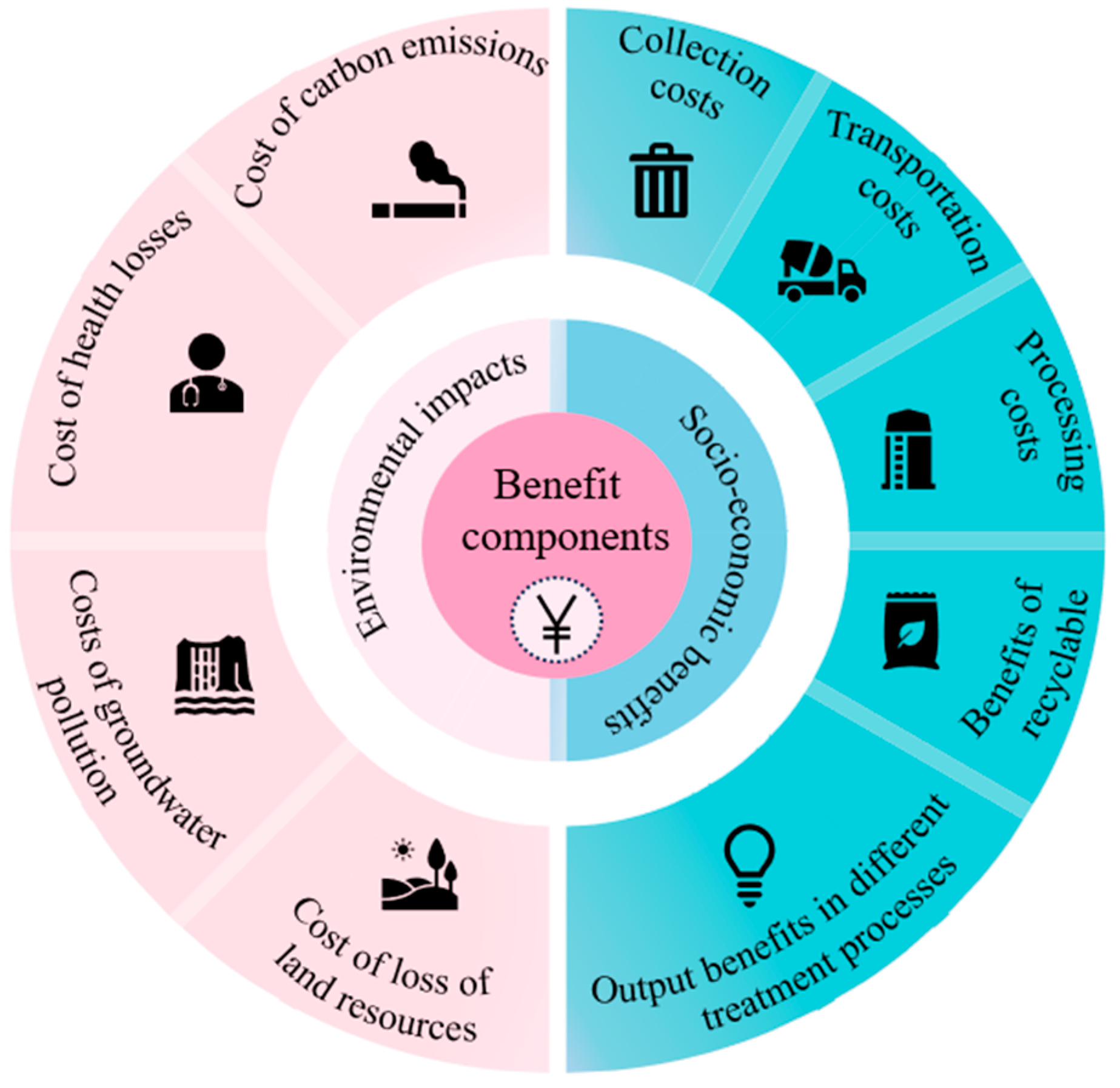



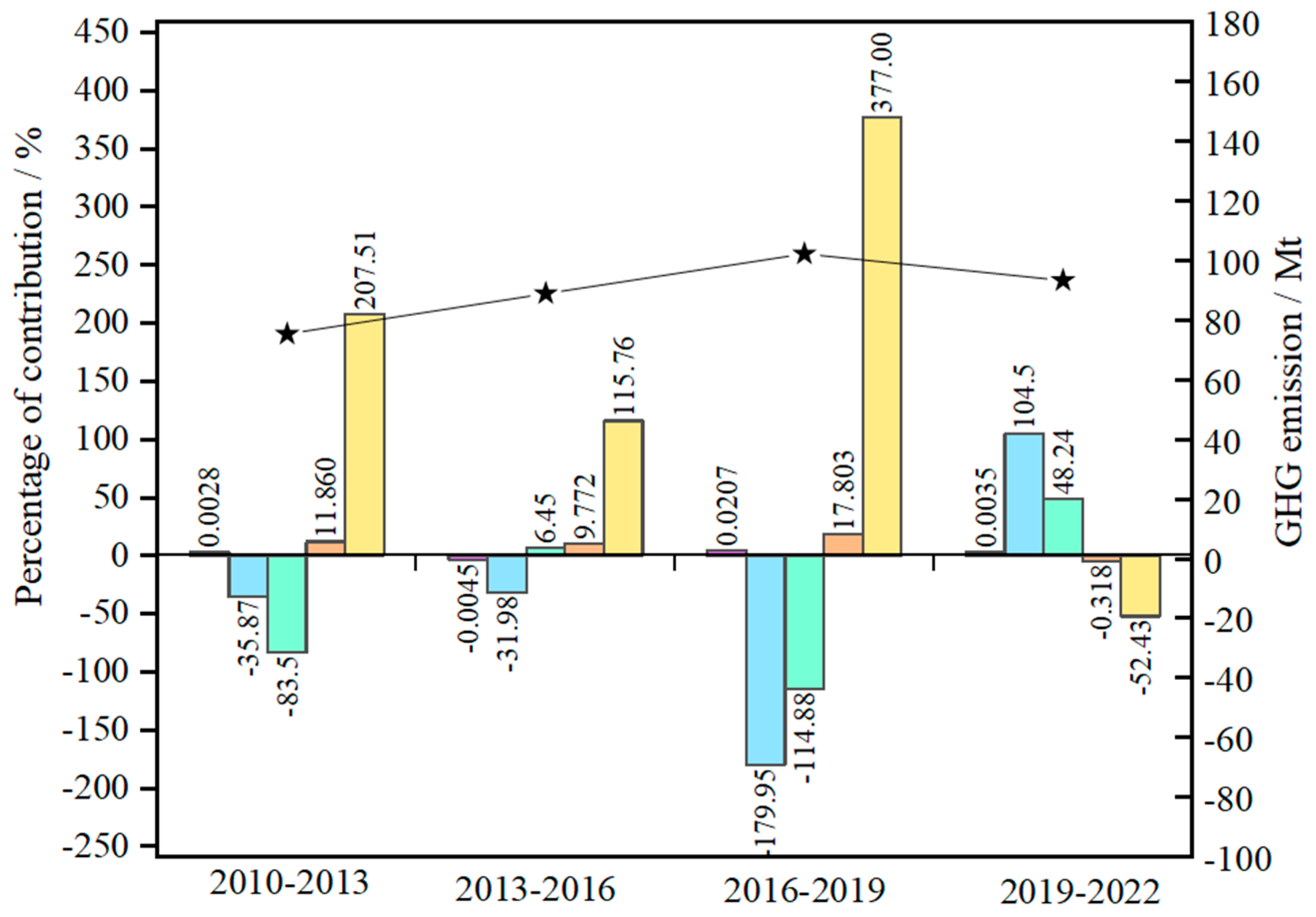
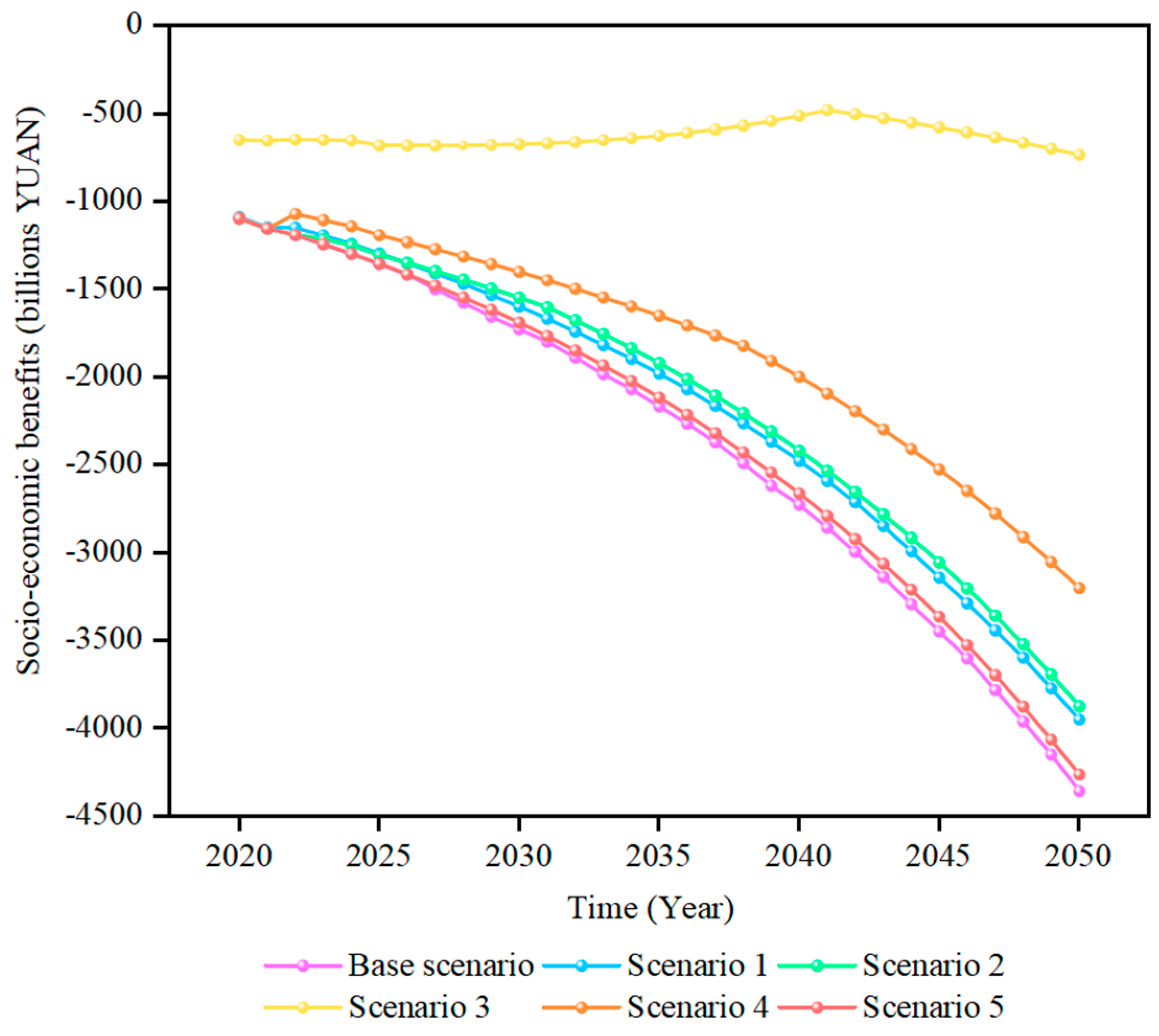
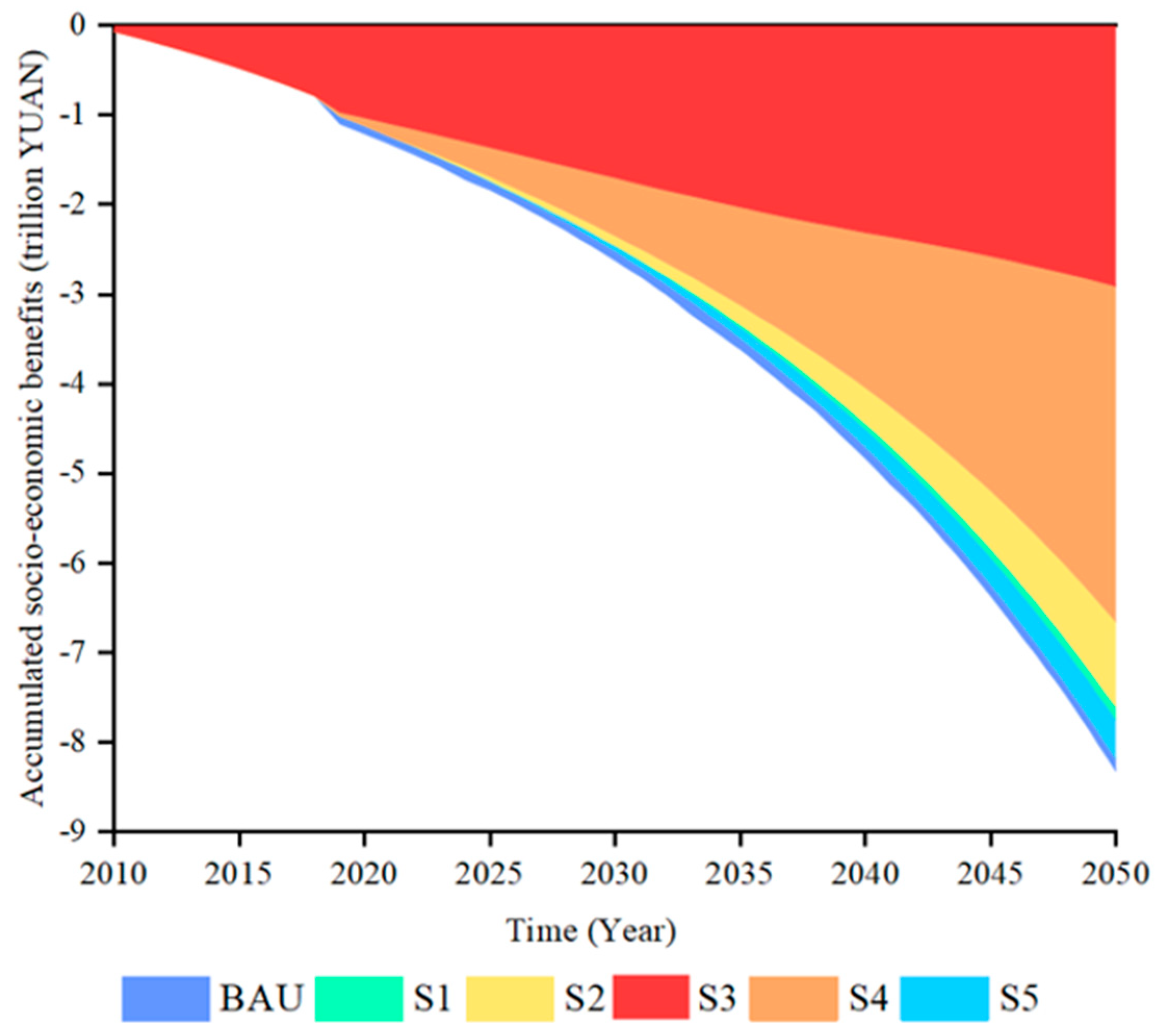
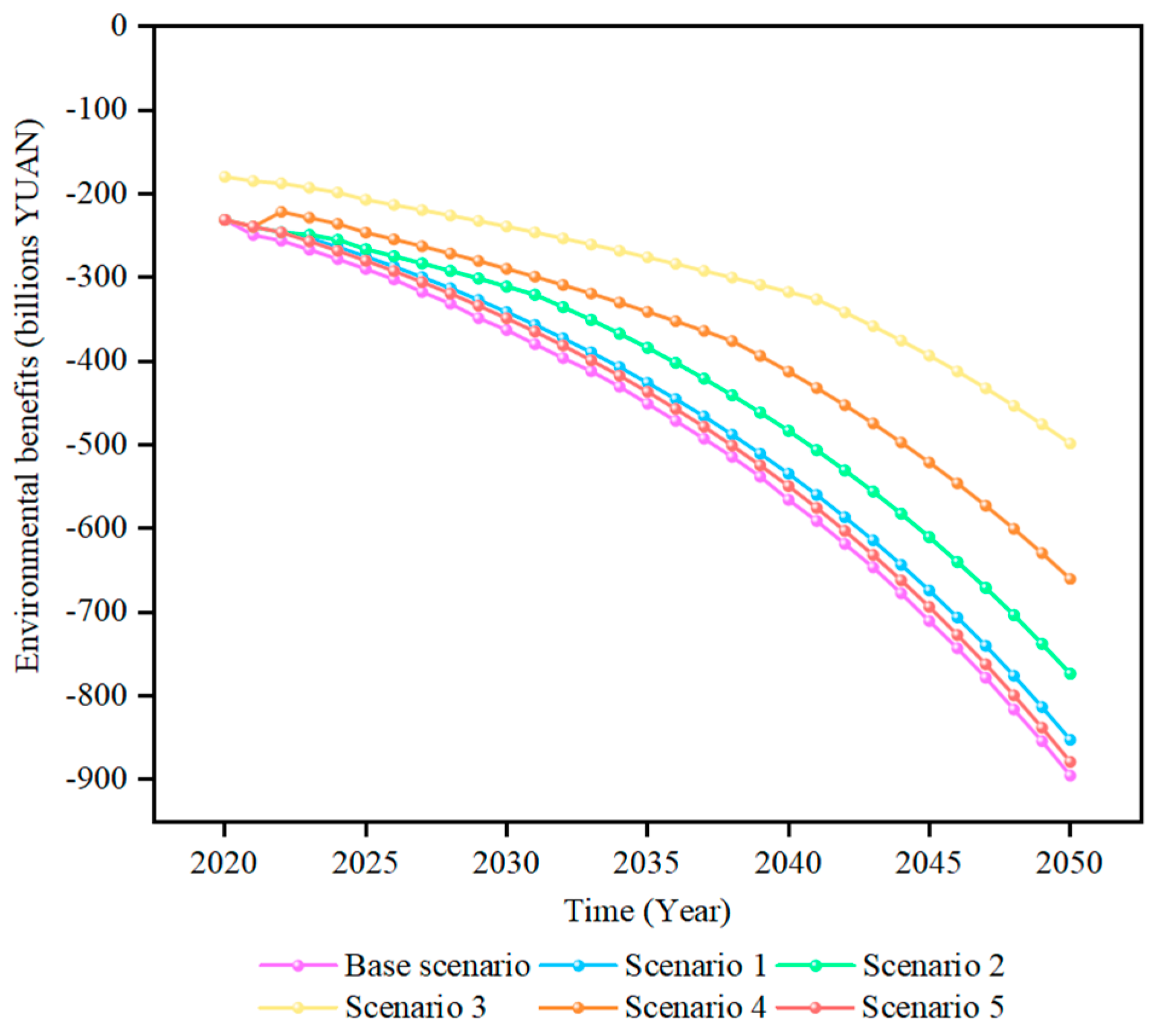
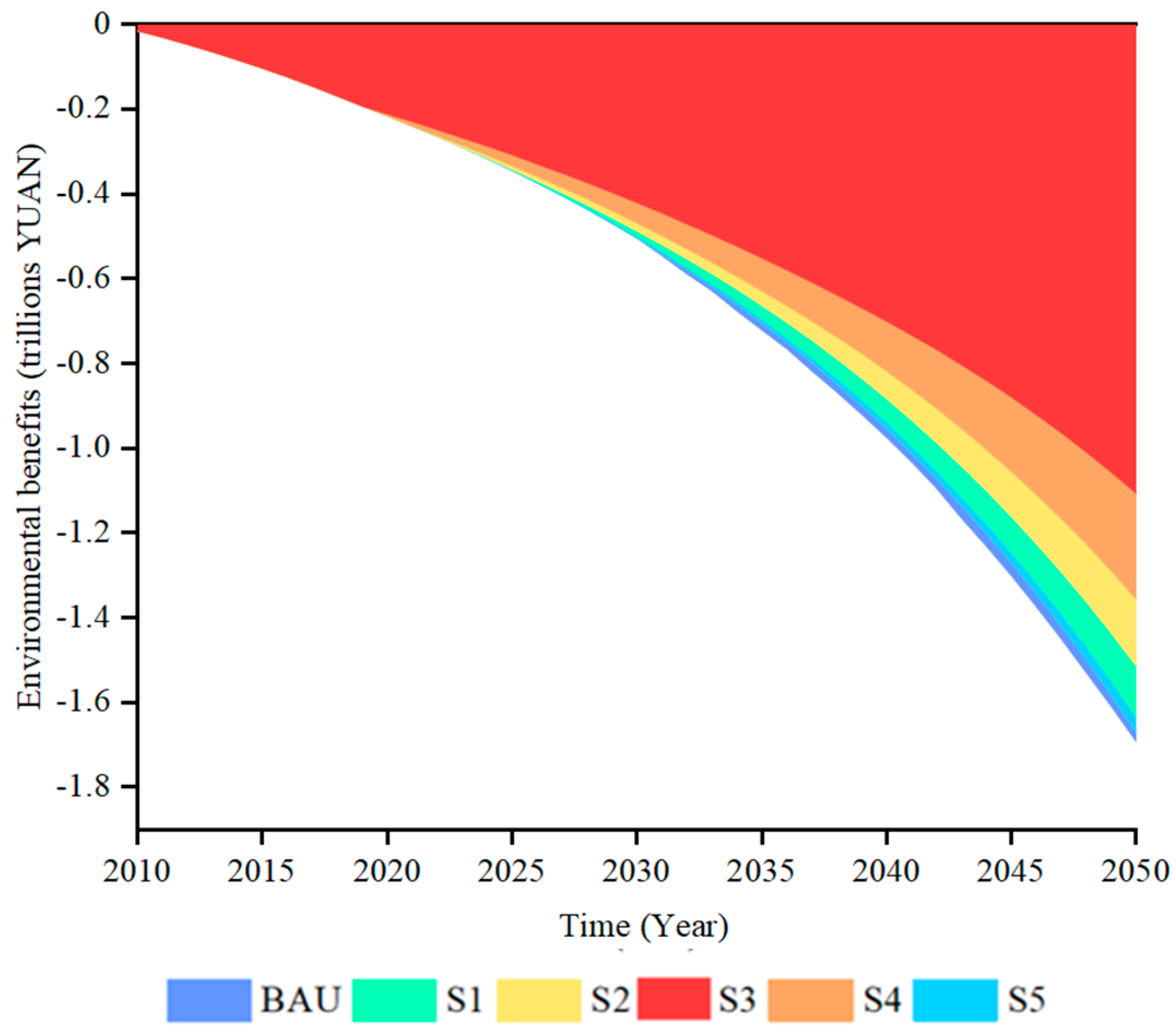
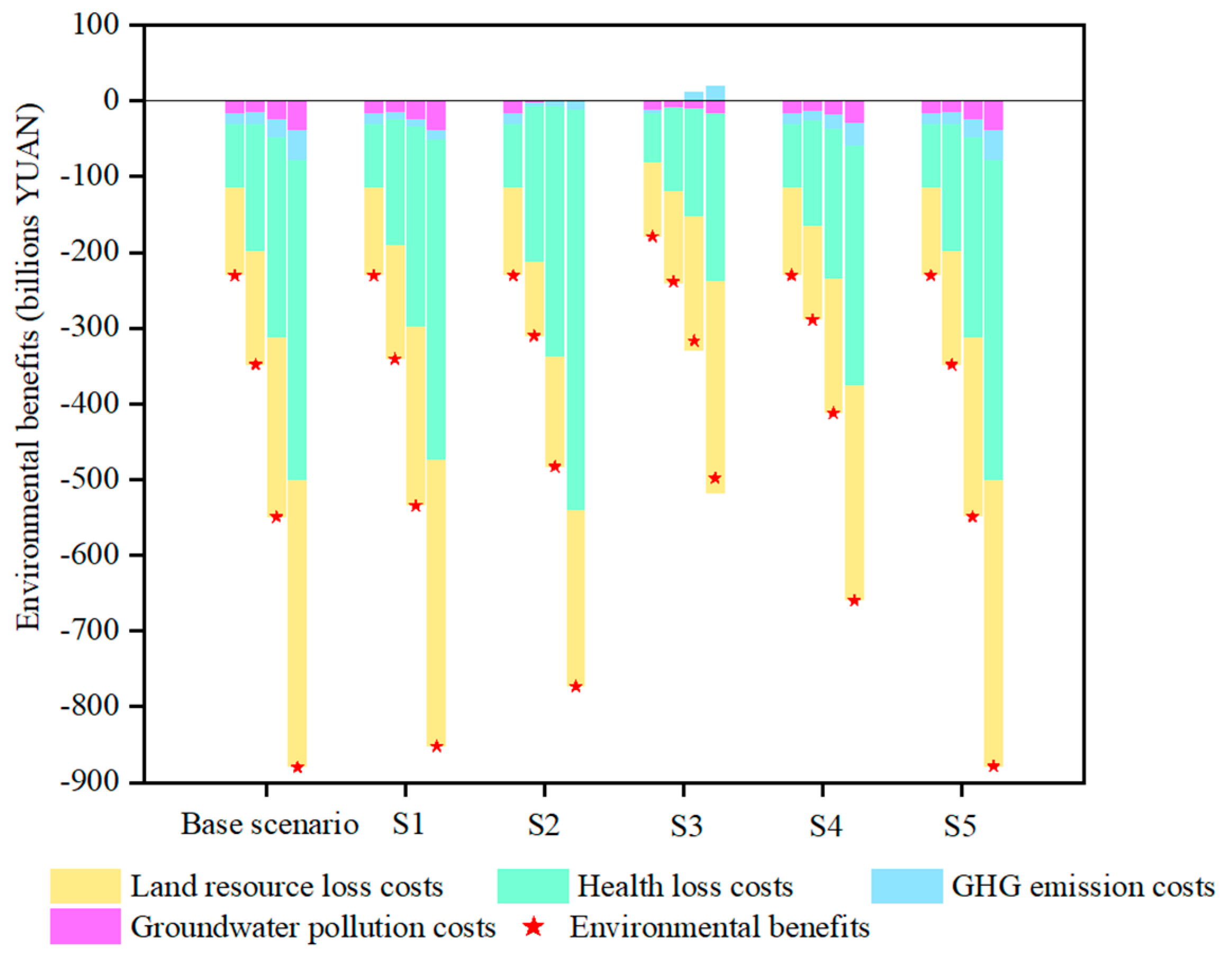
| Scenario | Driving Factor | Method | Parameter Setting |
|---|---|---|---|
| Base scenario | - | - | The MSW separation rate is 0, and the rest are based on the 2022 level of development. |
| Scenario 1 | Emission Intensity effect | Increasing the utilization rate of CH4 | The CH4 utilization is 40% in 2023, 50% in 2025, 70% in 2035 with 2% annual increases over the period, and 85% in 2050 with 1% annual increases over the period, and the rest are the same as in the base scenario. |
| Scenario 2 | Treatment Structure effect | Increasing the incineration rate | The incineration rate is 90% in 2025 and 100% in 2030, with a 2% annual incremental increase during this period to be maintained until 2050, and the rest are the same as in the base scenario. |
| Scenario 3 | Generation Intensity effect | Increasing the rate of MSW separation | The MSW separation rate will be 20% in 2020, 40% in 2040 with an annual increase of 2% during the period, and 65% in 2050 with an annual increase of 1% during the period, and the rest will be the same as in the base scenario. |
| Scenario 4 | Economic Development effect | Reducing the amount of per capita MSW generated | Per capita MSW generation is reduced to 90% of the previous level in 2023 and 75% of the previous level in 2038, with 1% annual reductions during this period maintained until 2050, and the rest remains the same as in the base scenario. |
| Scenario 5 | Population Scale effect | Slowing down the population growth rate | The population growth rate is 0.43% in 2023–2030, 0.33% in 2031–2040, and 0.23% in 2041–2050, and the rest are the same as the base scenario. |
| Driving Factor | 2010–2013 | 2013–2016 | 2016–2019 | 2019–2022 | ||||
|---|---|---|---|---|---|---|---|---|
| Contribution Rate (%) | Impact Degree (Mt) | Contribution Rate (%) | Impact Degree (Mt) | Contribution Rate (%) | Impact Degree (Mt) | Contribution Rate (%) | Impact Degree (Mt) | |
| ED | 207.51 | 2540.3 | 115.76 | 1915.5 | 377.00 | 2702.6 | 52.43 | 1624.5 |
| PS | 11.86 | 145.2 | 9.77 | 161.7 | 17.80 | 127.6 | 0.318 | 9.85 |
| GI | −83.5 | −1022.2 | 6.45 | 106.8 | −114.88 | −823.5 | −48.24 | −1494.6 |
| EI | 0.0028 | 0.034 | −0.005 | −0.07 | 0.0207 | 0.15 | −0.003 | −0.11 |
| TS | −35.87 | −439.1 | −31.98 | −529.1 | −179.95 | −1290.0 | −104.5 | −3237.9 |
Disclaimer/Publisher’s Note: The statements, opinions and data contained in all publications are solely those of the individual author(s) and contributor(s) and not of MDPI and/or the editor(s). MDPI and/or the editor(s) disclaim responsibility for any injury to people or property resulting from any ideas, methods, instructions or products referred to in the content. |
© 2025 by the authors. Licensee MDPI, Basel, Switzerland. This article is an open access article distributed under the terms and conditions of the Creative Commons Attribution (CC BY) license (https://creativecommons.org/licenses/by/4.0/).
Share and Cite
Zhang, G.; Lu, G.; Liu, K.; Liu, H. System Dynamics-Based Integrated Benefit Analysis of Low-Carbon Management Process of Municipal Solid Waste. Sustainability 2025, 17, 1193. https://doi.org/10.3390/su17031193
Zhang G, Lu G, Liu K, Liu H. System Dynamics-Based Integrated Benefit Analysis of Low-Carbon Management Process of Municipal Solid Waste. Sustainability. 2025; 17(3):1193. https://doi.org/10.3390/su17031193
Chicago/Turabian StyleZhang, Genping, Gang Lu, Kaili Liu, and Hongbo Liu. 2025. "System Dynamics-Based Integrated Benefit Analysis of Low-Carbon Management Process of Municipal Solid Waste" Sustainability 17, no. 3: 1193. https://doi.org/10.3390/su17031193
APA StyleZhang, G., Lu, G., Liu, K., & Liu, H. (2025). System Dynamics-Based Integrated Benefit Analysis of Low-Carbon Management Process of Municipal Solid Waste. Sustainability, 17(3), 1193. https://doi.org/10.3390/su17031193




